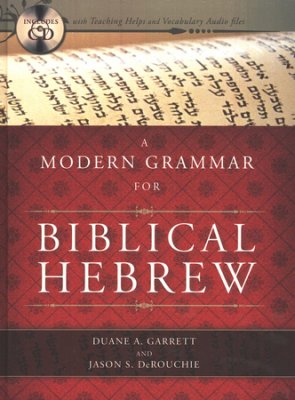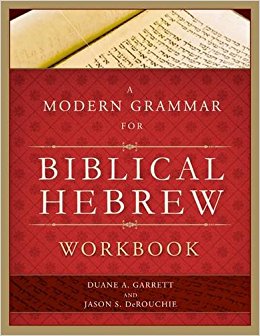Learning a language is not easy. You have to learn a new set of vocabulary, a new way to structure sentences, and new syntactical and grammatical rules just to be able to speak to somebody! It’s a bit different with Hebrew and Greek, as many student only learn to recognize and read the languages (unfortunately-languages stick better when you learn them through speaking and listening too). Duane Garrett (the John R. Sampey Professor of Old Testament at the SBTS) and Jason DeRouchie (Professor of Old Testament and Biblical Theology at Bethlehem Seminary) have come together and revised Garrett’s previous Hebrew textbook.
Outline
- Orthography (the conventions of spelling) and Phonology (chs 1-4)
- Basic Morphology and Syntax (chs 5-26)
- Detailed Study of the Qal Verb (chs 27-30)
- Detailed Study of the Derived Stems (chs 31-35)
- The Masoretic Text, Detailed Study of Syntax, and Poetry (chs 36-41)
Upon finishing chapter 41, the reader will have learned nearly all words that appear 79 times or more in the Hebrew Bible, 510 core vocabulary, 155 proper names, and will have translated over 300 verses of biblical text (along with many practice sentences). A CD is included with audio files for the alphabet and vocabulary.
The Chocolate Milk
I’ve found Garrett/DeRouchie’s grammar to be a helpful guide. Most chapters are packed with information (though this can be a double-edged sword), which is helpful for self-study and for after-class-need-more-time-to-let-this-soak-in-study. In chapter six, “Hebrew Verbs,” the authors give a very helpful discussion on verb tense, mood, aspect, and voice.
- Tense tells us if the “situation expressed by the verb is past, present, or future” (35).
- Mood tells us whether the action (expressed by the verb) is real/actual (“was,” “is,” or “will”) or possible (“may,” “would,” “could”).
- Aspect “relates to how a speaker portrays the action” (35). Are we told “it [the whole event] happened” or that “it was happening” (as a process)?
- Voice “tells us whether the subject of a verb acts or is acted upon” (36). This is seen in active verbs (“The dog bit the man”) and passive verbs (“The man was bitten by the dog”).
Each chapter has a section on vocabulary, and beginning with chapter nine the reader is presented with a guided reading from Psalm 1, Numbers 1.24–35, Psalm 14, and various texts from Genesis. The authors cover the expected grammar of Hebrew: nouns, adjectives, adverbs, prefixes, etc. But Section E has six chapters, one on Masoretic marks, and five covering syntax and literary structure, discourse analysis, and poetry. These chapters give important advice on sentence clauses, speech, embedded discourse, paragraph markers, and more. There is a case study in historical discourse in Genesis 37.2–11 which will benefit any who put the time into understanding it. It’s not enough to know vocabulary and to be able to parse; you must know how to read sentences and paragraphs and to know how the sense units function in relation to each other. This is a large task, and Garrett and DeRouchie faithfully guide their beginners through these ravines.
The Workbook is excellent. Each chapter comes with many sentences to translate and many verbs to parse for extra practice. It’s unfortunate that the reader isn’t required to translate from English in Hebrew. It actually helps to reinforce what was taught in the chapter. Bonus: The workbook has an answer key (I’ve actually seen some books that do not have an answer key, which boggles my mind).
The Spoiled Milk
As I said above, almost every chapter is is packed with information, which can be a real benefit. But when I open A Modern Grammar I feel like I’m drowning in words. Though helpful, it can really be overwhelming.
The flip side to my praise of the chapter on verbs (ch 6) is followed up by my distaste for the chapter on verbs. Right off the bat, I’m a paradigm guy. I’ve seen that there are some people who have really appreciated that the chapters on verbs didn’t list paradigms. I’m not one of those people. That’s just not how my mind works. So even though I had already had a semester of Hebrew, this chapter still threw me for a loop.
The chapter quickly introduces the reader to the verb יִפֹּל (yippol) and it’s meaning, gloss, and alternative translations. The first verb reader meets is a weak verb. On the next page the reader is given six more verbs, and again, all are weak verbs (which are more difficult to properly recognize than the strong verbs). Then יִפֹּל (yippol) is described as an imperfect verb, what Garrett refers to as the yiqtol (יִקְטֹל) verb. קָם (qam) is a perfect verb, or a qatal verb. My point? יִפֹּל doesn’t look like יִקְטֹל, and קָם doesn’t look like קָטַל. The vocabulary list at the end of the chapter contains 15 verbs; two are strong. The rest are weak (and, thus, act differently).
Why not explain the perfect verbs (קָטַל) by strong verbs that actually like like the verb קָטַל? why use a weak verb with only two radicals (or ‘letters’) instead of three? Weak verbs are difficult enough to understand. Why begin verbs with them?
In fact, I found all/most of the chapters on verbs to be at least somewhat confusing. On the one hand, the explanations are excellent, but the format of the chapters (and lack of paradigms, though they are in a back appendix) was unhelpful.
Recommended?
Yes, though in a number of ways I still prefer both Allen Ross’ grammar (which you can find free lectures here) and Van Pelt/Pratico’s grammar (my review here). Part of that is because I’ve worked through both of them (and Ross’ in Hebrew I & II). I also think both grammars are laid out better than this one. This one has a lot of good information in it, but it does require a lot of reading. Some chapters also try to get too far ahead of themselves by providing a brief look at a grammatical rule that will be examined in a later chapter.
Chapter 1, when learning about vowels there’s a brief section about how nouns in construct can change their vowels. Yet this topic won’t be covered until chapter 12. Why not just leave it until then? Had this been my introduction to Hebrew, seeing vowels change in this way would have felt like a burden.
I still think that Garrett and DeRouchie have put together an excellent grammar, one that tries to give the reader all the information they need to understand the language. But this wouldn’t be the first grammar I reach for, nor the first I recommend as I don’t find it the simplest grammar to go through, but with self-discipline and patience one can surely make it through this grammar with a firm understanding of both beginning Hebrew and syntax.
Lagniappe
- Authors: Duane Garrett & Jason DeRouchie
- Hardcover Grammar: 432 pages
- Paperback Workbook: 320 pages
- Publisher: B&H Academic (July 1, 2009)
Buy the Grammar from B&H Academic or on Amazon!
Buy the Workbook from B&H Academic or on Amazon!
Review Disclosure: I received this book free from B&H Academic. The opinions I have expressed are my own, and I was not required to write a positive review. I am disclosing this in accordance with the Federal Trade Commission’s 16 CFR, Part 255 http://www.access.gpo.gov/nara/cfr/waisidx_03/16cfr255_03.html.
Amazon Affiliate Disclosure: As an Amazon Associate I earn from qualifying purchases.



Reblogged this on Talmidimblogging.
LikeLike